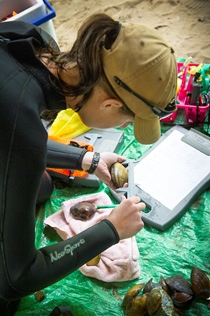Mussel relocation aids dam removal project in mid-Michigan
Removing obsolete, unsafe and unnecessary dams from Michigan’s rivers and streams has been on the Department of Natural Resources’ to-do list for a long time, as fisheries managers strive to remove obstacles to natural fish movement.
In some case, it’s a relatively easy assignment. Sometimes, though, natural resources managers run  into hurdles that take a lot of extra effort to jump. The Lyons Dam on the Grand River in Ionia County is a perfect example. into hurdles that take a lot of extra effort to jump. The Lyons Dam on the Grand River in Ionia County is a perfect example.
Built sometime before 1913 – the records are incomplete – the hydropower facility at Lyons was retired by Consumers Power in 1957. Since that time, the dam has provided little function.
In the mid-1990s, the DNR identified Lyons Dam as an unnecessary impediment to upstream fish passage on the Grand. DNR fisheries biologist Scott Hanshue said it took a while for the department to convince local officials that dam removal would be a good idea. Once it achieved that buy-in, the DNR was able to begin environmental studies that are required to facilitate dam removal.
During a preliminary study of the aquatic species below the dam, the DNR made a significant discovery: A number of mussels that appeared on the state’s list of endangered and threatened species are right at home below Lyons Dam. The most significant of these mussels – the snuffbox – was under consideration for inclusion on the federal endangered species list when it was found there. It has since been added to that list.
The mussels were discovered by Daelyn Woolnough, a mussel ecologist and assistant professor at Central Michigan University, who accompanied Hanshue on a survey.
“It’s the densest population of snuffbox that has ever been quantified in North America,” said Woolnough, who admits to being a little bit excited by the discovery. “This mussel is in the most endangered genus of the freshwater mussel groups, because 14 of the 26 known species are extinct. The remaining species are rare and federally endangered.
 “We’re finding snuffbox mussels of all age classes and both sexes, in even sex ratios, and we’re finding gravid females.” “We’re finding snuffbox mussels of all age classes and both sexes, in even sex ratios, and we’re finding gravid females.”
The presence of the mussels wasn’t enough to put the kibosh on the dam removal, but because the mussels were found in areas where heavy equipment would be used, they had to be relocated before the dam demolition could begin.
Working with a number of her students as well as DNR personnel, Woolnough found similar habitat downstream from the dam and began the process of moving mussels – and not just snuffbox.
“We never find the snuffbox by itself; it’s kind of a social mussel,” Woolnough said. “Rare species are often found in communities of other mussels.”
Because scientists don’t totally understand the nature of the relationship among the various mussels, Woolnough and her aids are moving all the mussels they find.
“So far we have found 17 species alive and four species of shells only,” she said. “We have relocated more than 500 mussels including 20 snuffbox, but are expecting to find more.”
 Relocated snuffbox are fitted with passive integrated transponder (PIT) tags. Unlike tags for fish, which usually are inserted into the fish’s body cavity, these are glued onto the shell and encapsulated. Relocated snuffbox are fitted with passive integrated transponder (PIT) tags. Unlike tags for fish, which usually are inserted into the fish’s body cavity, these are glued onto the shell and encapsulated.
“We will be able to track them over time for years to come,” Woolnough said. “We’ll be able to tell if they move, if they’re growing, and if they’re reproducing.”
Woolnough hopes to have her work completed by the end of October. Actual dam removal likely will occur in July, when the river flow is at a minimum.
Removing the dam probably will result in snuffbox moving upstream, where they are not currently found, but where appropriate habitat exists. Fish, which will benefit from additional river access, play an important role in mussel reproduction.
When these mussels reproduce, the males release sperm into the water column, which is taken in by the female. Larval mussels – glochidia – are held inside the females.
“The neat thing about the snuffbox is they are considered trappers – the female opens its shell a little bit and the fish swim in,” Woolnough said. “The mussel traps the fish and then, like a bellows, releases the larval mussels into the gills of the fish, the fish swims away, and the larval mussels hitch a ride with the fish.”
The microscopic glochidia develop on their hosts for 20 to 30 days and when the time is right, they drop off wherever the fish are and settle into the substrate.
“Surveys upstream of the dam show excellent substrate, but no snuffbox,” Woolnough said. “It’s likely  the fish are not getting upstream off the dam.” the fish are not getting upstream off the dam.”
Hanshue said that surveys showed good fish habitat upstream of the dam.
“There are a lot of walleyes in that stretch that are looking for places to spawn,” he said. “This might give them the potential to spawn in that area – as well as smallmouth bass and other sport fishes.”
Removal of the Lyons Dam will open up 6 miles of river, up to Webber Dam, but it isn’t the distance that’s important, said Hanshue. “It’s the quality of the habitat that we’re restoring.”
The Lyons Dam project involves the most extensive mussel relocation effort Hanshue’s ever heard of. “MDOT has had to move mussels that were stranded due to drawdowns for construction at several sites in the past, but nothing like this,” he said.
“This is the most unique conservation project I’ve worked on in my career,” said Woolnough. “People in my field are extremely interested in this species and excited that we are able to do something.”
Learn more about the state’s endangered species on the DNR website www.michigan.gov/wildlife.
/Note to editors: Photos to accompany this story are available for download at www.michigandnr.com/ftp/outreach in the folder marked “Lyons Dam Mussels.” (Michigan DNR photos)
Captions:
DSCN 1533 – Divers search for mussels below Lyons Dam in Ionia County.
DSK 528 27 – A graduate student measures mussels being relocated from below Lyons Dam.
DSK 528 31 – Male and female mussels of the same species often can be identified by the shapes of their shells.
DSK 528 37 – A dive team from Central Michigan University searches for mussels below a bridge just downstream from Lyons Dam.
DSK 528 48 – Federally endangered snuffbox mussels are being relocated from below Lyons Dam before the dam is taken out./
The Michigan Department of Natural Resources is committed to the conservation, protection, management, use and enjoyment of the state’s natural and cultural resources for current and future generations. For more information, go to www.michigan.gov/dnr.
|